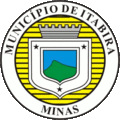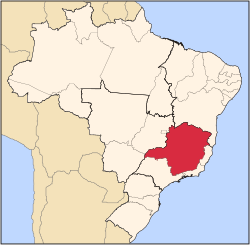Itabira | |
|---|---|
| Municipality of Itabira | |
| Nicknames: | |
 Location in Minas Gerais | |
| Coordinates: 19°37′08″S43°13′37″W / 19.61889°S 43.22694°W | |
| Country | |
| State | |
| Region | Southeast |
| Intermediate Region | Belo Horizonte |
| Immediate Region | Itabira |
| Government | |
| • Mayor | Marco Antônio Lage (PSB) |
| Area | |
• Total | 1,253.704 km2 (484.058 sq mi) |
| Elevation | 795 m (2,608 ft) |
| Population (2020 est.) [6] | |
• Total | 120,904 |
| • Density | 96.4374/km2 (249.772/sq mi) |
| Demonym | itabirano |
| Time zone | UTC−3 (BRT) |
| HDI (2010) | 0.756 – high [7] |
| Website | itabira |

Itabira is a Brazilian municipality and a major city in the state of Minas Gerais. The city belongs to the Belo Horizonte metropolitan area mesoregion and to the Itabira microregion.
Contents
It is currently the twenty-fourth largest city in the state in terms of population, with 120,904 inhabitants, according to a 2020 IBGE survey. It is known as the "Capital of Poetry", by virtue of being the birthplace of poet Carlos Drummond de Andrade, is part of the Circuit of the Gold and of Estrada Real.









